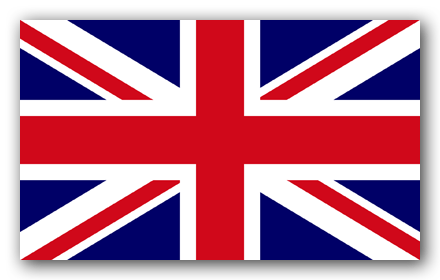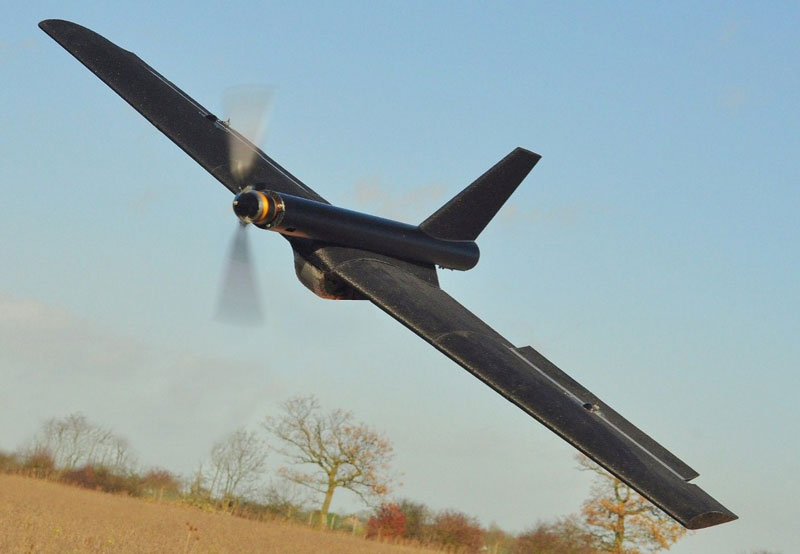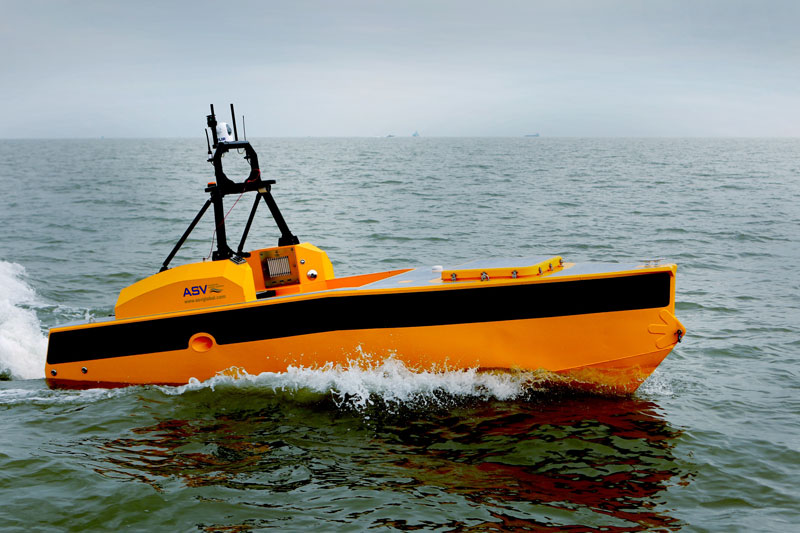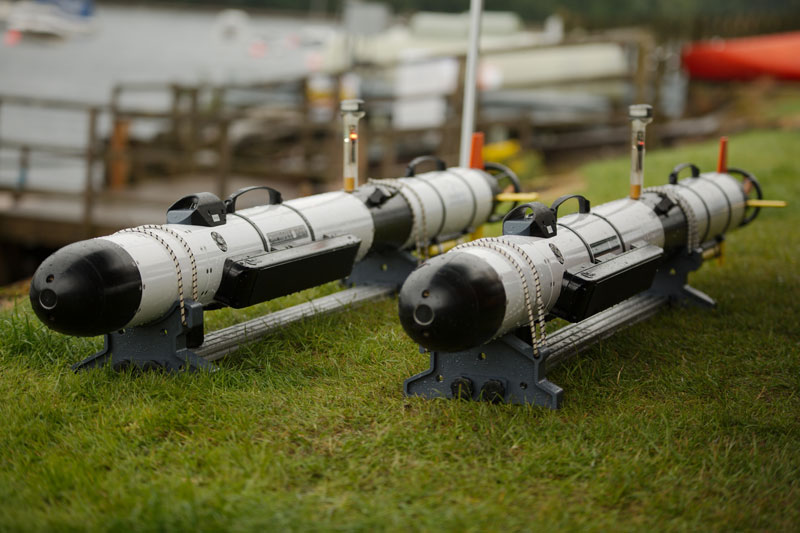United Kingdom Naval Drones

Latest News
Northrop Grumman to Demonstrate Unmanned Mine Hunting for Royal Navy
2 September 2016 - Northrop Grumman Corporation will demonstrate its unmanned mine hunting capability during the Royal Navy`s upcoming Unmanned Warrior exercise.
QinetiQ to Integrate Unmanned Air, Sea, and Subsea Vehicles
18 August 2016 - QinetiQ will provide the UK component of a multinational demonstration of unmanned and autonomous systems under a new contract with the Defence Science and Technology Laboratory (Dstl).
The demonstration, dubbed Hell Bay 4, will see a variety of unmanned underwater, surface and air vehicles working co-operatively within a number of squads, autonomously undertaking mine countermeasures missions.
QinetiQ will lead a team that includes Seebyte, Blue Bear Systems Research and ASV in the exercise, which involves participants from the US, Canada and Australia.

Blue Bear Blackstart unmanned aerial vehicle
Hell Bay 4 will be delivered under the Maritime Autonomy Framework (MAF), a Dstl-led initiative and development programme that has enabled the UK to participate in a number of regular multinational demonstrations and trials. Phase one of the Framework established software and architecture to test Unmanned Underwater Vehicles (UUV), with Phase Two seeing the integration of an Unmanned Surface Vehicle (USV) into a cooperative squad.

ASV C-Worker 5 unmanned surface vehicle
QinetiQ is contracted to deliver the third phase of the MAF, in which an Unmanned Aerial Vehicle (UAV) will be introduced into the squad to provide situational awareness and communications relay to vehicles on and under the water. It will bring together underwater vehicles operated by the Royal Navy’s autonomous systems trials team, an unmanned C-Worker 5 surface vehicle provided by ASV and the Blue Bear Blackstart UAV.
The contract win is the fifth in a year for the QinetiQ Maritime Autonomy Centre (QMAC), established in 2013 to accelerate the UK’s adoption of autonomous systems by facilitating their design, development, testing and evaluation.
Hell Bay 4 will take place in Scotland in October as part of Unmanned Warrior, the Royal Navy’s showcase event demonstrating the potential of unmanned and autonomous systems. Unmanned Warrior involves over 40 different organisations and 50 vehicles undertaking challenging military missions in a demanding environment. QinetiQ is leading the Command and Control component of Unmanned Warrior and playing a key role in enabling the overall programme.
Lisa Hunter-Yeats, programme lead said: “We are really excited to be working with Dstl on this important programme. MAF has a really strong reputation in pushing the boundaries in maritime autonomy; we have great partners and a strong team and are looking forward to Unmanned Warrior in October.”
Phil Brown, programme lead in Dstl, said: “I am pleased to be working with QinetiQ and their partners and am confident that Hell Bay 4 will be the latest in a series of very successful multinational demonstrations, pushing forward the boundaries in maritime autonomy.”

Seebyte Iver unmanned underwater vehicles
Royal Navy 700X Squadron Commanding Officer Interview
22 December 2015 - IHS Jane's speaks to Lieutenant Commander Matt Nelson, Commanding Officer 700X Naval Air Squadron on the development of Royal Navy unmanned aerial systems including recent operations in the Arabian Gulf
Southampton Engineers Test Fly "Printed" Aircraft off HMS Mersey
24 July 2015 - A 3D printed aircraft has successfully launched off the front of a Royal Navy warship and landed safely on a Dorset beach.
Royal Navy Establishes Drone Squadron
27 November 2014 - The Royal Navy has stood up the 700X (X for ‘eXperimental)’ Naval Air Squadron at the RNAS Culdrose to oversee the development of its unmanned air vehicles.
The Squadron is responsible for operating the ScanEagle UAS aboard Royal Navy vessels as well as testing newer unmanned aircraft. Lt Commander Al Rogers, the squadron's first commanding officer, said, “This is a fantastic job. It’s the Fleet Air Arm’s first step into the world of remotely piloted air systems and we are looking to develop our tactics and embrace this new technology ensuring the Royal Navy remains a world leader in aviation at sea – whether manned or unmanned.”
Royal Navy Survey's D-Day Exercise Wrecks with Naval Drones
22 April 2014 - A mission off the coast of South Devon, England has surveyed two U.S. Landing Ship Tanks (LSTs) that were torpedoed and sunk during the D-Day rehearsal Exercise Tiger on April 28, 1944. Using state-of-the-art autonomous underwater vehicle (AUV) technology to collect data from the wreckage site, the mission has produced the first high-definition sonar images of this World War II tragedy. This was the first time in history that an AUV had surveyed the area.
The mission, which was executed by Hydroid, Inc., a subsidiary of Kongsberg Maritime and the leading manufacturer of AUVs, with additional data provided by the Royal Navy's Maritime Autonomous System Trials Team (MASTT), commemorates the 70th anniversary of Exercise Tiger. A tragic but largely unknown military operation, Exercise Tiger was a D-Day rehearsal for the invasion of Normandy's Utah Beach. The exercise took place off the southern English coast and resulted in the loss of nearly 1,000 American servicemen - more than the number of deaths at the actual invasion of Utah Beach.
The REMUS 100, a Hydroid AUV used for the mission, is designed to perform intricate oceanographic surveys over large areas. The vehicle is equipped with multiple sonar instruments that enable it to capture high-resolution imagery of objects on the sea floor. Using these instruments, Hydroid was able to secure close proximity, high-quality side scan and wide swath interferometric bathymetric multi-beam sonar images of the two LST wreck sites. The data show that both LSTs are about 50 meters below the surface and reach between six to eight meters above the seafloor. The REMUS 100 also discovered an object of interest close to the shore which may hold significance in relation to Exercise Tiger. An effort to identify this object is currently underway by the Royal Navy.
While Hydroid operated in the English Channel about 30 miles out to sea, MASTT focused on the waters just off Slapton Sands where the Exercise Tiger beach landing took place. The information collected by MASTT's REMUS 100 was an important supplement to the efforts of the Hydroid team. To commemorate the 70th anniversary of Exercise Tiger, Hydroid and the Royal Navy will be donating images obtained from this mission to the UK National Archive and local memorials.
"We hope that the data collected on this mission will shed additional light on this tragic event and help bring some closure to the families who lost their loved ones during Exercise Tiger," said Richard 'Bungy' Williams, Regional Manager, Hydroid Europe. "We are proud to use our technology to honor the memories of the servicemen who lost their lives in this tragic operation."
Royal Navy Purchases Autonomous Systems Software
13 September 2013 - Seebyte Systems has announced that the UK’s Defence Science and Technology Laboratory (Dstl) has purchased both SeeTrack Military and SeeTrack Neptune licenses in support of the Royal Navy Maritime Autonomous Systems Trials Team (RN MASTT).
Dstl is focused upon maximising the impact of science and technology for defence and security within the UK. As part of this focus, Dstl has been working closely with the Royal Navy to ensure the delivery of state-of-the-art capabilities. At present, Dstl is working with RN MASTT, formally the Fleet Unmanned Underwater Vehicle Unit (FUUVU), to implement the tactical development of Unmanned Underwater Vehicles (UUVs), allowing them to be used for underwater force protection.
SeeByte’s SeeTrack Military software is an open-architecture platform solution enabling mission-planning, monitoring, post-processing and reporting of off-board assets such as UUVs and diver hand held system; it is now the tool of choice for sixteen of the world’s navies. SeeTrack Neptune provides a payload control architecture and real time autonomy engine for UUVs to plan and execute well known patterns of behaviour that expedite and optimise single vehicle and multi-vehicle operations. In other words the operators plan for what to do and SeeTrack Neptune decides how to do it.
Alastair Cormack, Technical Client Manager at SeeByte, commented: “We are privileged to be in a position to assist the Royal Navy with their goal of improving defence and security within the UK. With fifteen other navies currently using SeeTrack software, it is fantastic that the UK MOD will now of state-of-the-art capabilities. At present, Dstl is working with RN MASTT, formally the Fleet Unmanned Underwater Vehicle Unit (FUUVU), to implement the tactical development of Unmanned Underwater Vehicles (UUVs), allowing them to be used for underwater force protection.
Phil Brown of Dstl Naval Systems also commented: “Recent work performed for the UK MoD’s S&T Programme by SeeByte and BAE Systems, as part of the Osprey Consortia, has resulted in the development of improved autonomous planning and control systems for delivering unmanned mine countermeasures. I am very pleased to say that the latest results of this work are being exploited into the UK RN, with software being provided to the RN MASTT for testing and evaluation.”
Designing for Drones from the Keel Up
21 August 2012 - The UK MoD announced that unmanned systems will feature prominently in the new Type 26 frigate, described by the First Sea Lord as "the future backbone of the Royal Navy." Along with a UAV-compatible flight deck, the ship will house a flexible mission bay including a ramp to allow deployment of rigid-hulled inflatable boats, unmanned surface vehicles, or a towed array sonar. Unmanned systems offer a modern multi-purpose combatant unique capabilities. Unmanned naval systems extend the ship’s sensor range, provide persistent intelligence coverage, and a reduce crew risks for certain missions such as mine-clearance.
According to the MoD, the vessel will feature “flexible mission space for unmanned air, surface and underwater vehicles, or additional boats.” This space is important, but not the only factor to consider when designing a ship for unmanned system compatibility. Other unmanned system carrying vessels, such as the U.S. Navy’s Littoral Combat Ship, may provide insight for the RN as they proceed with the Type 26's detailed design. Five factors are necessary to integrate unmanned vehicles into a naval vessel: 1) the vehicles themselves, along with their accompanying sensors and payloads; 2) power, support, and handling equipment including cradles and cranes; 3) spare parts, special tools, fuel, and other consumables; 4) trained crew or detachments to operate and maintain the vehicles; and 5) the software, hardware, and networks that either allow the drones to operate alone or integrate into the ship’s combat system.
Some of these factors are obvious, such as adequate hangar space and compatible cooling and electrical connections. Others have been gleaned from operational experience. Early Navy UAV programs, such as the Pioneer, did not realize their full potential as they were not integrated with the ship’s systems. Lessons learned from these UAS operations were adapted as the Fire Scout’s ground control station equipment was made integral to the LCS Sea Frame. A shortcoming in the initial LCS design, however, was adequate berthing for her core crew. The ship’s company is inextricably linked to the operation of the mission packages, even though the she carries unmanned system detachments. The problem will be rectified with twenty additional berths in later LCS iterations.
Manning requirements are also driven by how the drones will be employed. Assuming the Royal Navy’s ScanEagles and other UAVs will fly intelligence missions from the Type 26, decisions must be made on whether processing, exploitation, and dissemination (PED) of the information gathered will occur onboard or off. Although there are pros and cons to either solution, essentially organic PED drives additional manning and habitation requirements. Off-board PED is less man-power intensive (locally), but requires robust data-links and extra satellite band-width to transmit the intelligence to a ground station or command ship.
A final design consideration will be the proper mix of manned to unmanned vehicles each frigate will embark. In the case of LCS' aviation systems, a ratio of three Fire Scouts to one manned helo was choosen to allow for 24 hour air coverage based on approximately seven hours of endurance for Fire Scout and three hours of endurance for the MH-60. The manned/unmanned ratio must also take into account factors such as the payloads and sensors required for each mission set, and the need for a man on the scene in certain operations such as search and rescue. Because the Type 26 has excess design capacity and flexibility, these operational decisions can be made prior to each deployment.
comments powered by Disqus